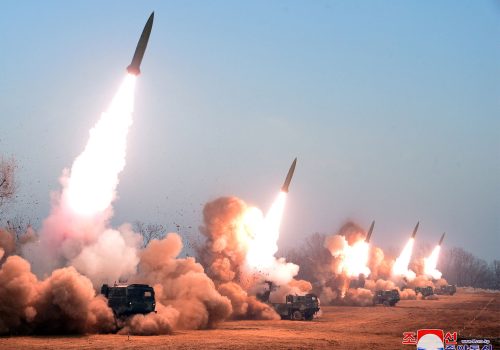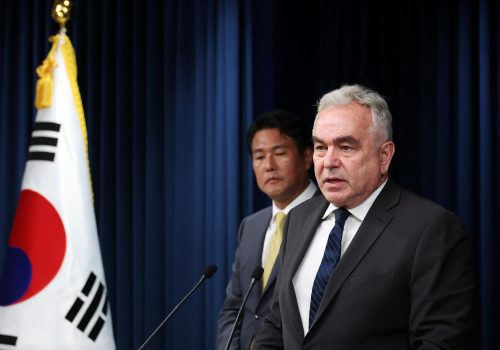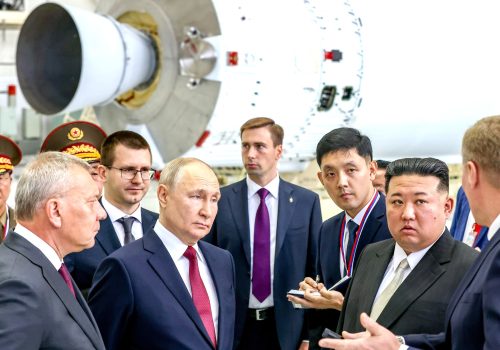Experts react: Are the US and South Korea following through on the Washington Declaration?
The deterrence is in the details. In April, South Korean President Yoon Suk Yeol and US President Joe Biden unveiled the landmark Washington Declaration on nuclear deterrence and consultation, part of an ambitious agenda laid out at their summit to strengthen the seventy-year-old US-South Korea alliance and deter North Korea from launching an attack. This week, US and South Korean defense officials and military leaders met in Seoul for two meetings that, while long-standing annual events, have taken on a new urgency following the Declaration: the fifty-fifth Security Consultative Meeting (SCM) between top civilian defense officials and the forty-eighth Military Committee Meeting (MCM) between four-star military officers. Below, Atlantic Council experts break down the results of these meetings and share their insights on whether the ambitions set out in April are becoming a reality now.
Click to jump to an expert analysis:
Markus Garlauskas: The work has begun to operationalize and institutionalize progress
Bee Yun Jo: Progress is being made in all five pillars of extended deterrence
Brad Gericke: The US-South Korea “Defense Vision” is where the rubber meets the road
Jessica Taylor: US-South Korea cooperation now needs new operational plans to go with it
Lauren D. Gilbert: The alliance will need a bottom-up approach to weather domestic uncertainty
Kyoko Imai: Building the foundation for Seoul-Tokyo-Washington cooperation
The work has begun to operationalize and institutionalize progress
These meetings faced high South Korean expectations to quickly demonstrate progress beyond “just words” since the April summit, and exceeded these expectations in several areas that Bee Yun Jo highlights below. As the recent Atlantic Council report “Deterrence is crumbling in Korea: How we can fix it” explains, the alliance is facing new drivers of risk to deterrence, so the United States and South Korea need to take steps to reduce the risk of strategic deterrence failure. Given the seriousness of the risk of North Korea using chemical and nuclear weapons in particular, Major General (retired) Brad Gericke zeroes in on the importance of getting the details right for alliance preparations to counter the use of such weapons of mass destruction (WMD) where “the rubber meets the road.”
Though details from meetings are often scant in public communiques, the SCM readout did include specific new language on alliance preparations to meet nuclear attacks: a table-top-exercise with nuclear use focus for the first time; discussion of including North Korean nuclear use during a future alliance military exercise; and even “joint execution and planning” for South Korean military support to US nuclear operations. Such measures strengthen “deterrence by denial” by signaling the alliance’s ability to “fight through” a nuclear attack, as well as better positioning the alliance if deterrence fails. Though less camera-friendly than deploying aircraft carriers, missile submarines, and bombers, these new measures have deterrent weight beyond displaying long-established capabilities.
This year, for the first time, the SCM was also bracketed by new multilateral defense meetings. A US-South Korea-Japan trilateral just before the SCM—as Kyoko Imai outlines—capitalized on political momentum to start operationalizing trilateral defense cooperation on missile warning and military exercises. Then after the SCM, representatives from United Nations Command member states—including rom Australia, Belgium, Canada, Denmark, France, Greece, Italy, Netherlands, New Zealand, Norway, the Philippines, South Africa, Thailand, Turkey, and the United Kingdom—met to declare their unity with the United States and South Korea in the event of renewed hostilities in Korea.
Overall, these meetings should go a long way in reassuring South Koreans, restoring the crumbing deterrence of North Korea, and strengthening multilateral mechanisms supporting alliance deterrence efforts. But—as Jessica Taylor warns—these meetings showed perhaps not as much progress toward the even more politically sensitive subject of preparing for and deterring a two-front war with China and North Korea. Ultimately, successfully operationalizing new defense measures in the alliance, particularly on politically sensitive topics, as Lauren Gilbert explains, will require consistent working-level follow-through to institutionalize the gains made in this year’s high-level meetings—before the favorable political climate that has enabled such progress shifts in the years ahead.
—Markus Garlauskas led the US intelligence community’s strategic analysis on North Korea as the national intelligence officer for North Korea, after serving as the chief strategist at the US-South Korea Combined Forces Command and US Forces Korea. He is the director of the Indo-Pacific Security Initiative at the Scowcroft Center for Strategy and Security of the Atlantic Council, and is @Mister_G_2 on X (formerly Twitter).
Progress is being made in all five pillars of extended deterrence
With the pressing need to show that the Washington Declaration and the newly inaugurated Nuclear Consultative Group (NCG) are “more than words,” this fifty-fifth SCM was surely a performance and credibility test for the alliance. The test results so far are encouraging.
Despite only seven months passing since the Washington Declaration was signed in April 2023, substantive progress is already evident in all five pledged areas to enhance extended deterrence against North Korean threats. As specified during the inaugural NCG meeting in July 2023, the five areas include: 1. information sharing (development of security and information sharing protocols against North Korean threats); 2. joint planning and execution; 3. a consultation mechanism (nuclear consultation and communication processes in crises and contingencies); 4. joint exercises, simulations, and training; and 5. enhancing visibility of US strategic asset deployments around the Korean Peninsula.
To highlight, new accomplishments out of the latest SCM are as follows. For information sharing, the allies have newly agreed to share data from US reconnaissance satellites by “expand[ing] cooperation of the US Shared Early Warning System (SEWS).” There is an evident shared understanding on the need to enhance the alliance’s joint detection capabilities if the alliance is to enable joint planning and execution of its capabilities against North Korean missile threats.
For joint planning and execution, the fifty-fifth SCM marked the signing of a newly revised joint South Korea-US deterrence strategy, known as the “tailored deterrence strategy (TDS).” While there were calls to update the TDS as North Korea continued to advance its nuclear and missile capabilities, the progress was limited and slow. The TDS, because it was written in 2013, was not able to fully reflect North Korea’s rapidly changing capabilities and offensive nuclear doctrine and scenarios, vis-à-vis US and South Korean capabilities. US Defense Secretary Lloyd Austin and South Korean Defense Minister Shin Won-sik’s final signing of the new TDS during the fifty-fifth SCM is a manifestation of the alliance’s expedited progress since the Washington Declaration and the establishment of the NCG.
More importantly, the fifty-fifth SCM highlighted the alliance’s renewed alignment in the means to enhance credibility of the United States’ nuclear umbrella: Via operationalizing conventional-nuclear integration of alliance capabilities. By expanding and specifying the “ROK-side role in preparation against DPRK’s nuclear and other WMD use and conventional threats,” the alliance seeks to operationalize the “full range of capabilities” against any North Korean attacks.
For consultation, there is also notable progress. When the NCG was first established in April, questions loomed on its role and possible overlap with the existing consultation mechanisms on extended deterrence, particularly the Extended Deterrence Strategy and Consultation Group (EDSCG) . However, as stated in the fifty-fifth SCM’s joint communique, the NCG is now to regularly update its activities “at future SCMs”; and its role is clarified as focusing on operational-level “work streams” of “joint execution and planning for ROK conventional support to US nuclear operations in a contingency.” Synchronization and coordination of the NCG within bilateral defense mechanisms signal substantive progress on alliance consultation.
While new measures are less visible in the fourth and fifth pledged areas, the fifty-fifth SCM clearly reaffirms allies’ continued efforts to expand and regularize exercises, as well as to enhance visibility of the United States’ strategic assets. A subtle but significant development that should not be forgotten is the alliance’s agreement to enhance “rotational deployments” of US strategic assets “in and around” the Korean Peninsula, instead of just “around” the Korean Peninsula, as it was described in earlier documents.
—Bee Yun Jo is a nonresident senior fellow in the Indo-Pacific Security Initiative at the Atlantic Council’s Scowcroft Center for Strategy and Security and an associate research fellow in the Defense Strategy Division at the Center for Security and Strategy at the Korea Institute for Defense Analyses.
The US-South Korea “Defense Vision” is where the rubber meets the road
As the SCM readout correctly stated: The “US-ROK Alliance is the linchpin of peace, stability, and prosperity on the Korean Peninsula and beyond.” Formal strategic engagements such as the SCM are essential to ensure the alliance successfully exercises this “linchpin” role, by aligning the US and South Korean governments on mutual interests of deterrence against North Korean or Chinese aggression in Northeast Asia.
Notably, this SCM declared that through a combined “Defense Vision” the US and South Korean armed forces will be “enhancing extended deterrence efforts against the Democratic People’s Republic of Korea (DPRK), modernizing Alliance capabilities by evolving into a science and technology alliance, and strengthening solidarity and regional security cooperation with like-minded partners.” In military terms, this is where the rubber meets the road, and the details will matter greatly. Washington and Seoul have to get these details right.
Operational risk is high on the Korean Peninsula, despite the limitations of North Korea’s military. North Korea’s relative decline in conventional capabilities in some ways heightens operational risk, because it leaves Pyongyang with no good options other than employing WMDs in the event it triggers a full-scale conflict. North Korea can employ unmanned aerial systems (i.e. drones), small teams of infiltrators, and massive volleys of artillery and missiles. But none of these tools will threaten the survival of the South Korean government or state.
North Korea’s large repositories of chemical weapons and its nuclear arsenal present an extraordinary danger. If Pyongyang comes to believe that these are the only tools available to it to achieve its objectives, then it might use them, despite the risk of retaliation. The US and South Korean armed forces, whose numbers have generally trended down in recent years despite improvements in niche areas such as missile defenses, will likely find it challenging to quickly snuff out North Korean WMD attacks and then take the critical action of seizing North Korea’s WMD stockpiles and disabling its command and control systems. These latter tasks are critical missions for US and South Korean forces in the event of war. They would be difficult to accomplish and require ample resources, investments that the “Defense Vision” should prioritize.
— Major General Brad Gericke, US Army (ret.), is a nonresident senior fellow in the Indo-Pacific Security Initiative at the Atlantic Council’s Scowcroft Center for Strategy and Security. Most recently, Gericke served as the Army’s longest-tenured senior strategist and chief of plans.
US-South Korea cooperation now needs new operational plans to go with it
The SCM and MCM joint communiques go a step further toward extending the alliance’s security cooperation beyond the Korean peninsula. But until cooperation is institutionalized in the form of operational plans, it is unclear whether the alliance is prepared for a multi-front conflict in Northeast Asia. Through the Washington Declaration and the trilateral summit with Japan, South Korean and US senior leaders communicated a shared desire for the maintenance of peace and security across the Taiwan Strait. However, Yoon also declared that in the event of a conflict across the Taiwan Strait, South Korea would expect the United States to meet its treaty obligations to South Korea first. Yoon specifically voiced concern that North Korea would take advantage of a cross-strait contingency to carry out kinetic provocations against South Korea. This points to a discussion that the allies need to have concerning military readiness and how the alliance will operate during this possible scenario and others. To truly enhance deterrence, the United States, in cooperation with its allies, needs to demonstrate the political will and military capability to respond to a contingency beyond the peninsula.
Furthermore, the SCM joint communique mentions the significance that the EDSCG and the newly formed NCG will play in extended deterrence. However, it is unclear how these two groups differ from each other. As it stands, readouts from each meeting invoke similar language. To ensure that the NCG is not just seen as window dressing in efforts to address the South Korean public’s concerns, the alliance should clarify how these two groups differ.
—Jessica Taylor is a nonresident fellow in the Scowcroft Center’s Indo-Pacific Security Initiative. Taylor has served in the US Department of Defense in both military and civil service capacities for nearly twenty years.
The alliance will need a bottom-up approach to weather domestic uncertainty
Following the completion of the fifty-fifth SCM and the forty-eighth MCM, the US-South Korea alliance appears stronger than ever. The SCM joint communique described an alliance designed not only to strengthen deterrence in the Indo-Pacific, but one that also seeks to move beyond a primary focus on traditional security and into other areas, such as new and emerging technologies, democratic values, and stronger connections with other like-minded allies and partners.
While it currently appears natural that this progress will continue into the future and onto the hundredth anniversary of the alliance in 2053, history cautions that this might not be the case. South Korea faces a public push for its own indigenous nuclear weapons, a National Assembly election in early 2024, and a president with a falling approval rating. Meanwhile, the United States faces uncertainty in Congress and has an impending election in 2024 with far-reaching implications. This all serves to show that the political climate that has resulted in successes, including the Nuclear Consultative Group (NCG) and the Camp David Summit, could change at any moment.
The progress shown in the SCM and MCM is vital, but to truly solidify the nature of these changes, implementation is required from the bottom up. Similar convenings beyond the ministerial level are needed to discuss feasible operational strategies and to provide a trust-building mechanism that will eventually establish these changes as the norm. As we’ve seen in several such initiatives, those at the working level are key for lasting and impactful change, even amid upheavals in the political climate.
—Lauren D. Gilbert is an associate director with the Atlantic Council’s Indo-Pacific Security Initiative, housed within the Scowcroft Center for Strategy and Security.
Building the foundation for Seoul-Tokyo-Washington cooperation
On November 12—one day before the fifty-fifth US-South Korea SCM—Austin, Shin, and Japanese Minister of Defense Kihara Minoru held the first-ever Trilateral Ministerial Meeting. The proximity of these meetings is no coincidence. It signifies the importance of trilateral security cooperation to US-South Korea plans to safeguard peace and stability in the Indo-Pacific. More importantly, in a new and promising development in the bilateral relationship, South Korea and Japan have indicated their willingness to set aside long-standing differences to address mutual security concerns.
The most imminent regional security threat for both countries is North Korea’s growing nuclear and missile stockpile. While Pyongyang has traditionally succeeded in creating wedges between the two countries, its belligerent rhetoric and barrage of weapons testing have pushed Seoul and Tokyo closer than ever before. On top of this, the global security environment, including burgeoning military ties between North Korea and Russia, and the threat of a Hamas-style surprise attack by North Korean forces, has further heightened the trilateral partnership’s fears.
Although the US-South Korea-Japan partnership has strengthened significantly, this momentum won’t last forever. Relations between Japan and South Korea are particularly susceptible to swift reversals following changes in each country’s domestic political environments. With elections upcoming in the United States, Japan, and South Korea, the window of opportunity is narrowing rapidly. To prevent the dismantling of the immense progress that has been made thus far, the current administrations are intent on institutionalizing the trilateral partnership at warp speed.
In particular, the Camp David Summit—convening Biden, Yoon, and Japanese Prime Minister Kishida in August 2023—marked a new and forward-looking chapter in the trilateral partnership. The Trilateral Ministerial Meeting and subsequent SCM serve to reinforce the agreements made at Camp David with concrete and operational milestones for each deliverable. First, the ministers confirmed that the data-sharing mechanism to exchange real-time missile warning data of North Korean missile launches is in the final stages of testing and will be fully operational by year’s end. Additionally, the multi-year framework to conduct annual and multi-domain trilateral exercises—building on aerial exercise in October 2023—will also be finalized by December of this year.
Ultimately, the aim of senior leaders and working-level officials in Tokyo, Seoul, and Washington should be to lay the foundation for a trilateral partnership that is immune to drastic political swings in each country. The United States should also help create the building blocks to enable greater trust and direct coordination between Japan and South Korea. A truly trilateral common threat perspective and ability to share information will enable greater interoperability and wide-ranging opportunities for enhanced cooperation through future defense initiatives.
—Kyoko Imai is an assistant director with the Indo-Pacific Security Initiative (IPSI) of the Atlantic Council’s Scowcroft Center for Strategy and Security.
Further reading
Wed, Nov 15, 2023
China’s support for Russia has been hindering Ukraine’s counteroffensive
New Atlanticist By Markus Garlauskas, Joseph Webster, Emma C. Verges
A deep dive into trade data reveals how materials imported from China are vital for Russia’s ability to sustain its continued stubborn efforts to hold onto Ukrainian territory.
Wed, Jul 19, 2023
Experts react: South Korea embarks on a new nuclear era. How will it play out?
New Atlanticist By
US and South Korean officials just met in Seoul for the inaugural meeting of the Nuclear Consultative Group, a new bilateral platform to coordinate deterrence against a North Korean nuclear attack.
Wed, Sep 13, 2023
What the Putin-Kim authoritarian get-together means for Russia’s war and North Korea’s capabilities
New Atlanticist By
Experts react to Russian President Vladimir Putin and North Korean leader Kim Jong Un meeting at the Vostochny Cosmodrome in Russia.
Image: US Defense Secretary Lloyd Austin (L) and his South Korean counterpart Shin Won Sik attend a ceremony for the fifty-fifth Security Consultative Meeting in Seoul on Nov. 13, 2023. (Pool photo) (Kyodo)



